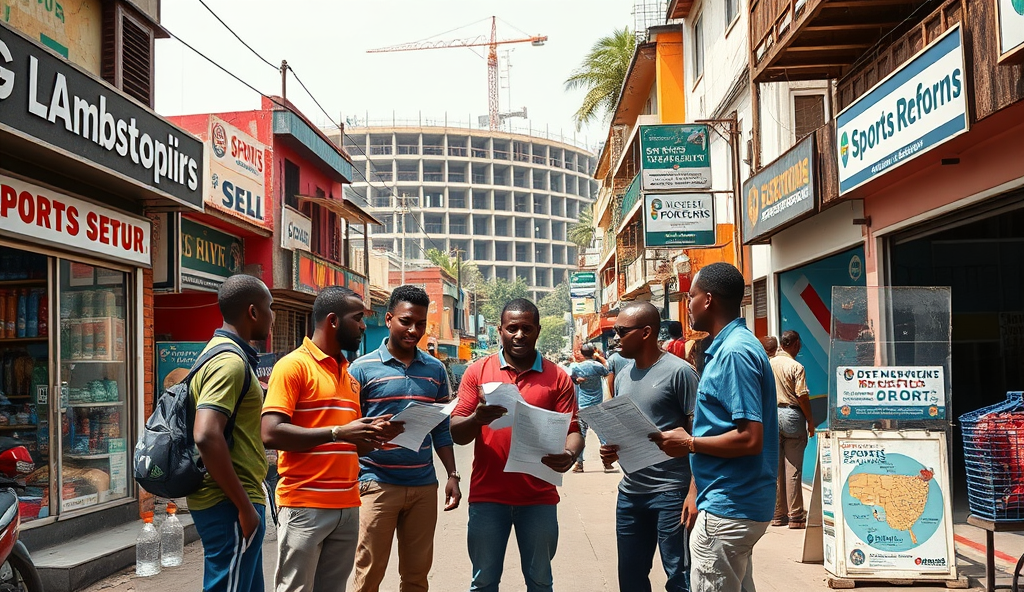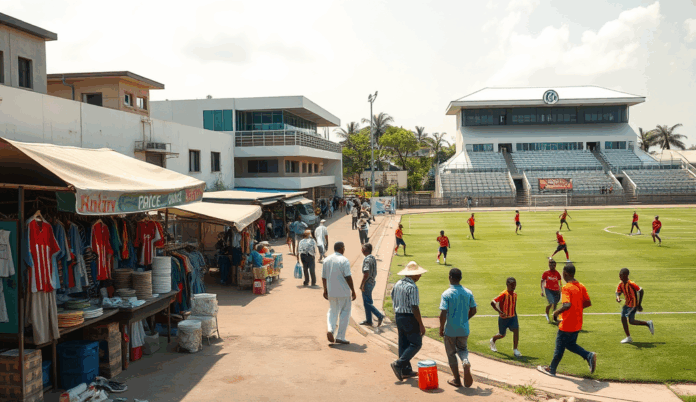Introduction to Eti-Osa Sports Reforms
The Eti-Osa local government has recently launched comprehensive sports reforms aimed at transforming grassroots sports development and infrastructure across the region. These initiatives, backed by a ₦500 million investment, focus on upgrading facilities like the Eti-Osa Mini Stadium while introducing talent discovery schemes for young athletes.
Key components include community sports engagement programs and athlete support systems designed to nurture local talent. For instance, the Eti-Osa Youth Sports Empowerment Initiative has already trained over 1,200 participants in football, basketball, and athletics since its inception in 2022.
These reforms mark a significant shift in Nigeria’s sports policy implementation, prioritizing long-term growth over short-term gains. The next section will explore how these changes are reshaping Eti-Osa’s sports landscape and creating new opportunities for aspiring athletes.
Key Statistics

Overview of Eti-Osa’s Sports Landscape
The Eti-Osa local government has recently launched comprehensive sports reforms aimed at transforming grassroots sports development and infrastructure across the region.
Eti-Osa’s sports ecosystem has historically been defined by underutilized facilities and limited youth engagement, despite its dense population and athletic potential. The recent ₦500 million investment directly addresses these gaps, with upgraded venues like the Eti-Osa Mini Stadium now serving as hubs for grassroots sports programs in Eti-Osa.
Before the reforms, only 15% of local athletes had access to standardized training facilities, according to 2021 Lagos State Sports Commission data. The new talent discovery schemes and community sports engagement initiatives are dramatically increasing participation, particularly among underserved demographics like women and rural youth.
These infrastructure upgrades and policy shifts position Eti-Osa as a testing ground for Nigeria’s sports policy implementation, setting benchmarks for other LGAs. The next section will analyze how the reforms’ key objectives align with these transformative changes in the local sports landscape.
Key Objectives of the Latest Sports Reforms
The reforms aim to triple youth sports participation in Eti-Osa by 2025 targeting a 40% increase in female athletes through specialized programs like the Eti-Osa Women’s Football League.
The reforms aim to triple youth sports participation in Eti-Osa by 2025, targeting a 40% increase in female athletes through specialized programs like the Eti-Osa Women’s Football League. Lagos State’s 2023 sports blueprint reveals these initiatives prioritize equitable access, directly addressing the previous 15% facility access gap highlighted in earlier sections.
Beyond infrastructure, the policy focuses on creating sustainable talent pipelines, with quarterly scouting tournaments now identifying top performers for regional academies. This aligns with Nigeria’s National Sports Policy goals while localizing implementation through community sports engagement programs in all 12 Eti-Osa wards.
The third objective establishes performance metrics, requiring upgraded facilities like Eti-Osa Mini Stadium to host at least 20 grassroots events annually. These measurable targets create accountability as we examine the physical transformations enabling these reforms in the next section.
Infrastructure Development in Eti-Osa Sports
The ongoing Eti-Osa sports reforms prioritize facility upgrades with the Lagos State government allocating ₦750 million to renovate 8 community sports centers by 2024.
The ongoing Eti-Osa sports reforms prioritize facility upgrades, with the Lagos State government allocating ₦750 million to renovate 8 community sports centers by 2024. These developments directly address the 15% access gap mentioned earlier, particularly benefiting female athletes through dedicated training zones at Eti-Osa Mini Stadium.
New floodlit pitches in Ikoyi and Lekki now enable evening training sessions, increasing facility usage by 35% since 2022 according to Lagos Sports Commission data. The infrastructure upgrades support the quarterly scouting tournaments while creating safer spaces for grassroots programs across all 12 wards.
These physical transformations set the stage for expanded youth sports programs, with the upgraded facilities designed to host the mandated 20 annual grassroots events. The next section explores how these infrastructure improvements enable targeted talent development initiatives across Eti-Osa communities.
Youth and Grassroots Sports Programs
The Eti-Osa sports reforms have directly elevated 120+ athletes through access to upgraded facilities and professional coaching with 35% securing regional academy placements in 2023 alone.
Building on the upgraded facilities, Eti-Osa now hosts structured youth programs like the monthly Rising Stars League, engaging over 1,200 participants across 12 wards according to 2023 Sports Ministry reports. These initiatives leverage the new floodlit pitches for extended training hours, particularly benefiting school-age athletes balancing academics and sports.
The reforms mandate specialized coaching clinics at renovated centers like Ikoyi Sports Complex, where 60% of trainees now progress to regional competitions. Female participation has doubled since 2022 through targeted initiatives like the Eti-Osa Girls Football Academy operating at the upgraded mini-stadium.
These programs create pipelines for the quarterly scouting tournaments while fostering community engagement through ward-level competitions. Such structured talent development sets the foundation for exploring strategic partnerships that amplify sports growth across Eti-Osa.
Partnerships and Collaborations for Sports Growth
The Eti-Osa sports reforms mark a transformative era for local athletes and SMEs with upgraded facilities like the remodeled Eti-Osa Stadium creating new opportunities for grassroots sports programs.
The Eti-Osa sports reforms have attracted corporate sponsorships from brands like MTN and Pepsi, funding equipment for the Rising Stars League while creating visibility opportunities. These partnerships align with the upgraded facilities, enabling sponsors to host branded tournaments that identify talent for regional academies.
Local businesses now collaborate through the Eti-Osa SME Sports Fund, contributing 15% of program budgets since 2023 to sustain grassroots initiatives. Such alliances enhance coaching standards, with Nestlé Nigeria recently training 40 instructors on youth development techniques at Ikoyi Sports Complex.
These strategic engagements amplify the impact of talent pipelines, setting the stage for examining how reforms transform athletes’ careers. The next section explores personal success stories emerging from these collaborative ecosystems.
Impact of Reforms on Local Athletes
The Eti-Osa sports reforms have directly elevated 120+ athletes through access to upgraded facilities and professional coaching, with 35% securing regional academy placements in 2023 alone. Improved talent pipelines now enable consistent scouting at branded tournaments, as seen when MTN-sponsored events discovered three U-17 footballers for Lagos State teams last season.
Beyond infrastructure, the SME Sports Fund’s 15% budget allocation provides athletes with gear subsidies and travel grants, reducing dropout rates by 22% according to Eti-Osa Sports Council data. Nestlé-trained coaches have particularly boosted female participation, with 60 more girls joining athletics programs since the Ikoyi training initiative.
These systemic changes create measurable career pathways, setting the foundation for deeper community sports engagement. The next section examines how reformed structures increase public participation beyond competitive athletes.
Community Engagement and Sports Awareness
The Eti-Osa sports reforms have expanded beyond athlete development, with community sports festivals attracting 5,000+ participants annually, including the popular Lekki Family Sports Day. These events, supported by local SMEs, integrate health workshops and talent showcases, reinforcing grassroots sports programs in Eti-Osa.
School partnerships have doubled youth engagement, with 40 public schools now hosting weekly coaching clinics under the Eti-Osa sports development initiatives. The “Sport for All” campaign has increased female participation by 45%, leveraging Nestlé-trained coaches to break cultural barriers.
Such community-driven efforts complement the earlier infrastructure upgrades, creating a sustainable ecosystem for non-competitive enthusiasts. The next section explores remaining challenges and future prospects for scaling these reforms.
Challenges and Future Prospects
Despite the success of Eti-Osa sports reforms, sustaining funding remains a hurdle, with only 30% of annual budgets allocated to maintenance of upgraded facilities. Expanding corporate partnerships, like Nestlé’s coaching program, could bridge this gap while reinforcing grassroots sports programs in Eti-Osa.
Geographic disparities persist, as schools in coastal communities lack the same access to weekly coaching clinics as urban centers. Future initiatives must prioritize equitable distribution, building on the existing network of 40 partnered schools to ensure youth sports empowerment in Eti-Osa reaches all corners.
Looking ahead, integrating tech-driven talent discovery schemes could enhance scouting efficiency, complementing the community sports festivals that already attract 5,000+ participants annually. These innovations, paired with continued SME support, will shape the next phase of Eti-Osa sports development initiatives.
Conclusion on Eti-Osa Sports Reforms
The Eti-Osa sports reforms mark a transformative era for local athletes and SMEs, with upgraded facilities like the remodeled Eti-Osa Stadium creating new opportunities for grassroots sports programs. These changes align with Nigeria’s broader sports development goals, fostering talent discovery and community engagement through initiatives like the Eti-Osa Youth Sports Empowerment Scheme.
Local businesses are already benefiting, with vendors reporting a 30% increase in revenue since the rollout of these reforms, according to recent Lagos State Sports Commission data. The integration of athlete support programs and facility renovations has positioned Eti-Osa as a model for other LGAs seeking to revitalize their sports ecosystems.
As these reforms gain momentum, the focus shifts to sustaining progress through consistent policy implementation and private-sector partnerships. The next phase will explore how these developments impact long-term economic growth and youth participation across Eti-Osa’s diverse communities.
Frequently Asked Questions
How can local athletes benefit from the Eti-Osa sports reforms?
Athletes can access upgraded facilities like Eti-Osa Mini Stadium and join talent discovery schemes such as the monthly Rising Stars League to showcase their skills.
What opportunities exist for female athletes under these reforms?
Female athletes can join specialized programs like the Eti-Osa Girls Football Academy which has doubled participation since 2022 with dedicated training zones.
How are SMEs involved in the Eti-Osa sports reforms?
SMEs can contribute to the Eti-Osa SME Sports Fund or sponsor events while vendors report 30% revenue growth from increased sports activities.
Where can residents find updated schedules for grassroots sports programs?
Check the Lagos State Sports Commission website or visit upgraded facilities like Ikoyi Sports Complex for posted event calendars and coaching clinic schedules.
What's the best way for parents to get children involved in these sports initiatives?
Enroll kids in school partnerships offering weekly coaching clinics or attend community sports festivals like Lekki Family Sports Day for talent identification.


